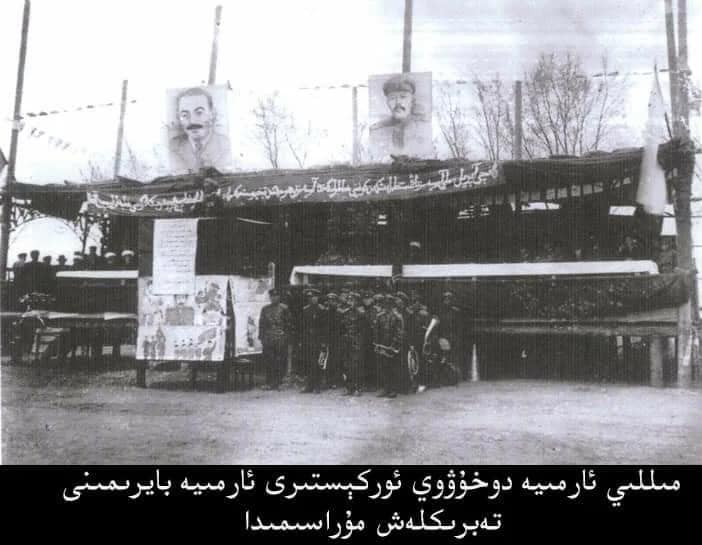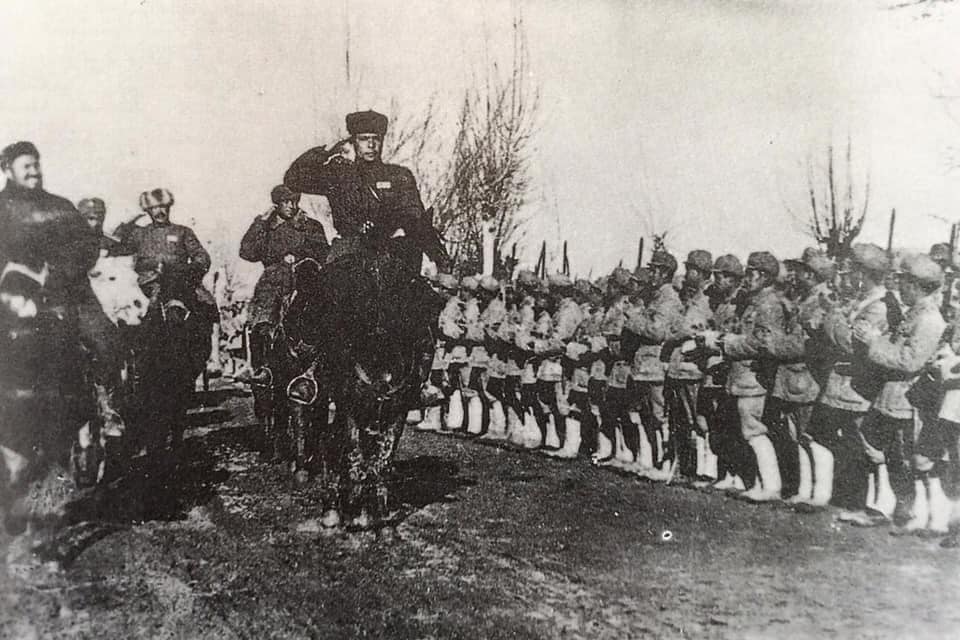76 years ago on April 8, 1945, the second East Turkestan Republic National Army was officially formed in the city of Ghulja in East Turkestan. It is a great honor for Uyghurs to commemorate this glorious day in our recent history.
In April, 1944, with the assistance of Consulate of former Soviet Union in Ghulja, an underground organization known as Ghulja Liberation Organization was officially proclaimed and Elihan Tore was elected as its grand marshall. On August 14, 1944, a partisan fighter group was assembled under the leadership of Patif Muslimov, Akber, Seyit and Ghani Batur in Ulastay, Nilka County. In October 1944, a revolution against vicious suppression of Kuomindang regime was errupted, a few victorious battles against Kuomintang Army was fought and soon the Nilka Township was liberated.
To cease the revolution, the Kuomintang government mobilized more than 3 thousand of its soldiers from Urumqi to surpress the revolts, however, their many attempts were defeated one after another by the newly formed East Turkestan National Army forces that soon liberated the city of Ghulja following the victorious battles in Harambagh, Airport and in langxiang over the Kuomintang Army. Subsequently, the founding of East Turkestan Republic was declared on November 12, 1944.
On April 8, 1945, an army flag handover ceremony was held in Ghulja and the establishment of East Turkestan National Army was officially declared. Uniforms and ordines simulated to Soviet Union Army and flag, emblems and badges were proposed and medals of Honor were awarded. Divisions like Military Distribution Department, Political Division, Martial Court and General Court-Martial were established under army headquarter. The Russian soldiers, Palinov and Mazarov who fled from the persecution of Soviet Red Army and later settled in Ghulja were elected as Chief Commander and Commander of Headquarter alike; Zunun Teyipov was elected as Deputy Chief Commander, Ghani Batur and Abdukerim Abbasov were elected General Court Martials and Commander of Political Division respectively. The total number of military personnel exceeded more than 40 thousand in relatively short period of time. Although the army was still new, but it showed extraordinary morale and disappiline. It defeated and drove the Kuomintang Army out of three municipals in East Turkestan and quickly set its course towards the Kuomintang government’s political and military center, Urumqi. Advancing towards Urumchi, the National Army took control of the territories on their path including the towns like Jing and Xiho. The towns were supposedly “an unbreakable defense line of Urumqi” installed by the Kuomingtang government. The National Army successfully proceeded towards Urumqi with total victories in battles along the way and later were ordered to camp near Manas River which was 150 km from the city of Urumqi.
At the same time, an army in the south was in the making and a commissioner was designated to organize armed revolts and uprising concentrated in the area of Tashmelik and Tashkorgan. The preparation of a full-scale attack in the areas controlled by Kuomintang invaders was underway. The East Turkestan National Army, on the other hand, liberated strategic locations and counties of Bay and Onsu and sieged Kuomindang army within the city of Aksu. Revolts big and small spreaded to many regions of East Turkestan, rebels attacked and annihilated local Kuomintang army units and Chinese army were almost in total defeat in inner parts of cities in numerous towns and cities.
Chinese Kuomintang officials in East Turkestan came to realize that they could not hold this occupied land any longer and began sending their families and valubles off to the Chinese provinces.
The second world war was coming to an end then, Chiang Kai-shek persuaded the American president Roosevelt to negotiate with Stalin. The end result was that for an exchange of recognizing the independent Mongolia, renting Luxun and Dalian ports to Soviet Union as a military base, having control over the building of a north-east railway in China, Stalin agreed to keep East Turkestan as a Chinese colony so that not only Russian military consultants be withdrawn, but also arms and ammunition sells to East Turkestan National Army be halted. At the same time, Soviet Union betrayed the people of East Turkestan Republic and they forced the leaders of ET to negotiate the terms with the Kuomintang government. After months of difficult talks, an agreement of “11 articles of peace” was reached in April, 1946. The agreement proposed that the East Turkestan Republic be revoked and a coalition government be formed. East Turkestan Army downsized per agreement to 6 battalions, thousands of rebels in the south of the country were forced to renounce the armed compaign and eventually were dissoved. Kuomintang’s continuous breach of the agreement led to the collapse of coalition government and delegates of East Turkestan were left no options bu to come back to Ghulja from Urumqi in August 1947. The East Turkestan National Army was expanded to 5 regiments, 3 infantry regiments and 1 independent horse battalion, a more integrated East Turkestan Army with more than 30 thousand soldiers were still in operation.
In 1949, the Chinese Communist Party won the the war against Kuomintang’s national party in decisive battles and the Kuomintang forces were forced to retreat to Taiwan in June. Soon after, the prime minister of Chinese communist party Liuciaoqi visited Russia. Russian government encouraged the Chinese should accelerate the pace of invading the East Turkestan. On 14 th August, 1949, Deng Liquan, the delegate of Chinese Communist Party and three of his assistants arrived in Ghulja in route of Kazakistan. According to the Chinese sources, on August 18, Mao Zedong telegrammed Ahmetjan Kasimi and invited him to the communist party’s CPPCC meeting to be held in September 1949 in Beijing. On August 20, Ahmetjan Kasimi telegrammed Mao and accepted his invitation.
Years after the dissolution of Soviet Union, in an interview with a former Soviet spy, Hakim Jappar Yarulla Bekof, who worked in Ghulja at the time, revealed that Ahmetjan Kasimi initially refused the Soviet proposal of participation of China’s first CPPCC without any preconditions. Hakim Jappar Yarulla Bekof suggested that to support the Chinese communist party’s propagandas and to comply with demands of taking part in China’s CPPCC, China must recognize East Turkestan as an independent state, or at least China must recognize East Turkestan Republic as a federal union like Soviet Union. Unless these conditions were met, participation in the CPPCC would not happen . The negotiation/discussion lasted for days often till midnight. Upon some serious discussion, Ahmetjan Kasimi, Ihsakbeg Munuluf, Delillkan Suhurbayov and other members of delegates stood their ground, claimed firmly that the East Turkestan Republic must be acknowledged as an independent state or be adopted into a federal union system. However, the delegates from Moscow failed to give a clear approval for the federal union proposal and the discussion ended without any meaningful resolution. Chinese communist party has been claiming that the delegates led by Ahmetjan Kasimi left from Alma-Ata on August 24,1949 and had a plane crash near Baikal Lake and all passengers on the plane were killed. CCP has also been claiming that the delegates of the East Turkestan Republic did agree in the participation of CPPCC without any political preconditions, they did not demand any rights and they fully uphold new China, etc. To our dismay, this untimely plane accident involving the leaders of East Turkestan Republic is never accepted by the Uyghur people. Until this day, Uyghur people still believe strongly that the plane crash cound not be coincidental, on the contrarary, it was a well-planned political game that was played by Russia and China at the expense of an independent East Turkestan.
The outcome of the Chinese civil war, Kuomintang’s Army was defeated and was forced to retreat to Taiwan. Chinese Communist Party prevailed, proclaiming the establishment of the People’s Republic Of China on October1, 1949.

Starting October 20, 1949, Chinese Communist Party began invading and occupying the entire East Turkestan with the assistance of Soviet Union.
In January, 1950, East Turkestan National Army was merged with CCP army. A year later, East Turkestan National Army was fully relinquished.
.The East Turkestan National Army, the pride of East Turkestani people and honorable symbol of proud history of East Turkestan, left eternal prints in the hearts and minds of generational Uyghurs and other turkic proples in East Turkestan. The army was no more exist and East Turkestan has been occupied and colonized by China, and, today, they are facing genocide by the brutal Chinese communist regime.
I hereby take great honor to commemorate the 76th anniversary of the East Turkestan National Army.
Long live independent East Turkestan!
Source:
Radio Free Asia
<<General History of Uyghurs>> by Dr. Nebijan Tursun

